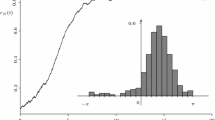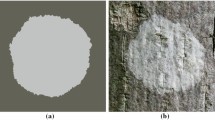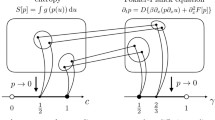Abstract
We study the variation of the stochastic process that describes the temporal behavior of the average degree of the neighbors for a fixed node in the Barabási-Albert networks. It was previously known that the expected value of this random quantity grows logarithmically with the number of iterations. In this paper, we use the mean-field approach to derive difference stochastic equations, as well as their corresponding approximate differential equations, in order to find the dynamics of its variation in time. The noteworthy fact proved in this paper is that the variation of this process is bounded by a constant. This behavior is fundamentally different from the dynamics of variation in most known stochastic processes (e.g., the Wiener process), in which its value tends to infinity over time.
This work was supported by the Ministry of Science and Higher Education of the Russian Federation in the framework of the basic part of the scientific research state task, project FSRR-2020-0006.
Access this chapter
Tax calculation will be finalised at checkout
Purchases are for personal use only
Similar content being viewed by others
References
de Almeida, M., Mendes, G., Madras Viswanathan, G., da Silva, L.R.: Scale-free homophilic network. Eur. Phys. J. B 86(38), 1–6 (2013)
Barabási, A., Albert, R., Jeong, H.: Mean-field theory for scale-free random networks. Phys. A 272(1), 173–187 (1999)
Bertotti, M., Modanese, G.: The configuration model for Barabasi-Albert networks. Appl. Netw. Sci. 4(1), 1–13 (2019)
Bianconi, G., Barabási, A.-L.: Competition and multiscaling in evolving networks. Europhys. Lett. 54(4), 436–442 (2001)
Cinardi, N., Rapisarda, A., Tsallis, C.: A generalised model for asymptotically-scale-free geographical networks. J. Stat. Mech.: Theory Exp. 2020(4), 043404 (2020)
Dorogovtsev, S.N., Mendes, J.F.F., Samukhin, A.N.: Structure of growing networks with preferential linking. Phys. Rev. Lett. 85(21), 4633 (2000)
Krapivsky, P.L., Redner, S.: Organization of growing random networks. Phys. Rev. E 63(6), 066123 (2001)
Krapivsky, P.L., Redner, S., Leyvraz, F.: Connectivity of growing random networks. Phys. Rev. Lett. 85(21), 4629 (2000)
Mironov, S., Sidorov, S., Malinskii, I.: Degree-degree correlation in networks with preferential attachment based growth. In: Teixeira, A.S., Pacheco, D., Oliveira, M., Barbosa, H., Gonçalves, B., Menezes, R. (eds.) CompleNet-Live 2021. SPC, pp. 51–58. Springer, Cham (2021). https://doi.org/10.1007/978-3-030-81854-8_5
Pachon, A., Sacerdote, L., Yang, S.: Scale-free behavior of networks with the copresence of preferential and uniform attachment rules. Phys. D 371, 1–12 (2018)
Pal, S., Makowski, A.: Asymptotic degree distributions in large (homogeneous) random networks: a little theory and a counterexample. IEEE Trans. Netw. Sci. Eng. 7(3), 1531–1544 (2020)
Piva, G.G., Ribeiro, F.L., Mata, A.S.: Networks with growth and preferential attachment: modelling and applications. J. Complex Netw. 9(1), cnab008 (2021)
Rak, R., Rak, E.: The fractional preferential attachment scale-free network model. Entropy 22(5), 509 (2020)
Shang, K.K., Yang, B., Moore, J., Ji, Q., Small, M.: Growing networks with communities: a distributive link model. Chaos 30(4), 041101 (2020)
Sidorov, S., Mironov, S.: Growth network models with random number of attached links. Phys. A: Stat. Mech. Appl. 576, 126041 (2021)
Sidorov, S., Mironov, S., Malinskii, I., Kadomtsev, D.: Local degree asymmetry for preferential attachment model. Stud. Comput. Intell. 944, 450–461 (2021)
Sidorov, S., Mironov, S., Agafonova, N., Kadomtsev, D.: Temporal behavior of local characteristics in complex networks with preferential attachment-based growth. Symmetry 13(9), 1567 (2021)
Tsiotas, D.: Detecting differences in the topology of scale-free networks grown under time-dynamic topological fitness. Sci. Rep. 10(1), 1–16 (2020)
Yao, D., van der Hoorn, P., Litvak, N.: Average nearest neighbor degrees in scale-free networks. Internet Math. 2018, 1–38 (2018)
Author information
Authors and Affiliations
Corresponding author
Editor information
Editors and Affiliations
Appendices
A The Proof of Lemma 1
Proof
Denote \(\beta _i(t):=\frac{s_i(t)}{d_i^2(t)}\). We have
Since
we get the difference equation
Using \(\mathbb {E}\left( \frac{1}{d_i(t)}\right) \sim \frac{i^{\frac{1}{2}}}{mt^{\frac{1}{2}}}\), we get the following approximate first order differential equation:
the solution of which is \(f(t)=\frac{1}{2} \left( \frac{i}{t}\right) ^{\frac{1}{2}}(\log t+b)\), where b is a constant.
\(\square \)
B The Proof of Lemma 2
To prove Lemma 2 we need two auxiliary Lemmas 3 and 4.
The next lemma complements the results of papers [9, 16].
Lemma 3
where a is a constant.
Proof
We have
Since
we get the difference equation
Using Lemma 1, we get the following approximate first order differential equation:
the solution of which is \(f(t)=\frac{m}{2}\log t-\frac{1}{2} \left( \frac{i}{t}\right) ^{\frac{1}{2}}\log t+\frac{1}{2} b\left( \frac{i}{t}\right) ^{\frac{1}{2}}+a\), where a is a constant.
\(\square \)
Lemma 4
where c is a constant.
Proof
We have
Since
we get the difference equation
Using Lemma 1, we get the following approximate first order differential equation:
the solution of which is \(f(t)=m \left( \frac{i}{t}\right) ^{\frac{1}{2}}\left( \frac{1}{4}\log ^2 t+\frac{b}{2}\log t+c\right) \), where c is a constant.
\(\square \)
Proof
(of Lemma 2) We have
Since
we get the difference equation
Using Lemmas 1, 3 and 4, we get the following approximate first order differential equation:
the solution of which follows
where d is a constant.
\(\square \)
Rights and permissions
Copyright information
© 2022 The Author(s), under exclusive license to Springer Nature Switzerland AG
About this paper
Cite this paper
Sidorov, S., Mironov, S., Tyshkevich, S. (2022). Surprising Behavior of the Average Degree for a Node’s Neighbors in Growth Networks. In: Benito, R.M., Cherifi, C., Cherifi, H., Moro, E., Rocha, L.M., Sales-Pardo, M. (eds) Complex Networks & Their Applications X. COMPLEX NETWORKS 2021. Studies in Computational Intelligence, vol 1072. Springer, Cham. https://doi.org/10.1007/978-3-030-93409-5_39
Download citation
DOI: https://doi.org/10.1007/978-3-030-93409-5_39
Published:
Publisher Name: Springer, Cham
Print ISBN: 978-3-030-93408-8
Online ISBN: 978-3-030-93409-5
eBook Packages: EngineeringEngineering (R0)




